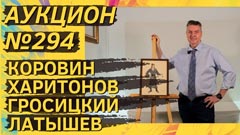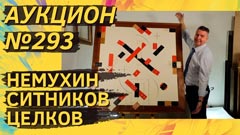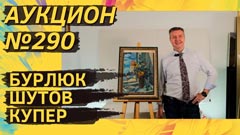
MASTERPIECES
KRASNOPEVTSEV Dmitry Mikhailovich (1925–1995) Wrapped bowl. 1972. Hardboard, oil. 54 × 37.5
Among the striking effects of Krasnopevtsev's “Wrapped Bowl” is the change in brightness and tonality depending on the angle from which you look at it. If you look straight ahead, the composition seems a little darker, but if you move half a step, the colors become brighter. There may be a scientific explanation for this: the paint lies intricately within the textural structure of the hardboard and the light is reflected differently. But the effect is truly mystical.
Krasnopevtsev is one of the most expensive artists of Russian unofficial art. Even after market corrections the prices of his metaphysical still lifes are often approaching and capable of surpassing the $100,000 mark. Unlike the works of many nonconformists, his paintings were highly prized even during the artist's lifetime. Krasnopevtsev was a favourite of George Costakis and Sviatoslav Richter. He was bought by composers, scientists and artists. The phenomenon of his art lies in the tactful philosophical approach to eternal questions. What is the meaning of life? What is good and evil? What is the nature of this world? Almost all of Krasnopevtsev's still lifes are the modernist variant of vanitas genre that illustrates the idea of frailty and vanity of vanities. His techniques are the arrangement of objects in perfect balance and at the same time without artificial symmetry (which is not characteristic of nature itself). The authenticity of the work was confirmed by the key researcher of creativity and the compiler of the catalogs of Dmitry Krasnopevtsev's paintings — Alexander Ushakov. He also helped establish the author's title. The picture is accompanied by the expert opinion of Valery Silaev.
The painting will be included in Krasnopevtsev's future updated catalogue-raisonné.
Particularly valuable period, good size, rare subject. Undoubtedly museum level.
RABIN Oscar Yakovlevich (1928–2018) Landscape with reflection. 1974. Oil on canvas. 60 × 80
The year 1974 is not just a valuable pre-emigration period, but also the year of the bulldozer exhibition organized by Rabin. And the atmosphere was oppressive. It would seem that the war had ended 30 years ago, that Stalin had been gone for 20 years, that communism was promised by 1980. And here... the hopelessness of a still barrack country and the threat that was in the air. The authorities were once again on the lookout for internal enemies. And for some reason they found them in independent artists. Like, they paint terrible pictures, communicate with foreigners and even try to push for their rights to be given exhibition halls. The response was provocations, summonses to the police, and the boorish closing of miraculously permitted exhibitions. In 1974, Rabin defied the authorities by organizing a peaceful demonstration, in the form of an open-air exhibition. In response, the artists were met with splashes of mud from watering machines and the clenched fists of “gardeners in plain clothes”. In the morning, the whole world learned about the beatings of the artists, and the exhibition itself went down in history as Bulldozer Exhibition.
CONTEMPORARY ART
VOLIGAMSI Rinat (1968) Character sitting in my chair. 2004. Canvas, acrylic, oil. 80 × 60
An upbeat, absurdist, kharmsian Voligamsi. I wouldn't call his paintings from this period surrealistic. The nature of the charm of his work lies elsewhere — in the combination of subtle humor and the obligatory philosophical content. Each painting is like a koan riddle for the Moscow conceptualists. Why did the legs replace the heart and the head? Why has man evolved into an ideal organism for eternal running? And why did he suddenly settle down when it was long overdue for a run?
Rinat Voligamsi is one of the rare contemporary artists whom we are not afraid to recommend for an investment collection. Our opinion — he is certainly a bright figure of the 2000s, which has already taken his place in the history of Russian art. Voligamsi — the favorite not only collectors, but also the public. Secretly, we tell you that soon will be launched a clothing line designed on the basis of his paintings — T-shirts and something else. Plots chosen as much as possible hooligan. With fights, flies and all kinds of mischief. In short, just the way we like it.
1960s UNOFFICIAL ART
NEMUKHIN Vladimir Nikolaevich (1925–2016) Jack of Targets. 2005. Canvas, acrylic, collage. 100 × 80
Sophisticated collectors of Nemukhin always pay attention to rare subjects. And we are facing one of them. Of course, we understand that Nemukhin worked in cycles, that he had more than one or five “jacks-targets”. But over the past three years, I do not recall a single one at our auction. And certainly not a museum-sized jack of one meter in height. And with such a complex elaboration — that it is difficult to understand from the photo, you need to look only alive. By the way, Nemukhin was usually far more laconic in his works and reduced the number of details. But for this jack he made an exception. The composition turned out to be saturated. Probably all these factors (size, relative rarity of the composition and richness) allowed the expert Valery Silaev to give this work the verdict “may have museum value”.
ZVEREV Anatoly Timofeevich (1931–1986) Girl in purple. 1966. Paper, watercolor, scratching. 67.5 × 47.5
ZVEREV Anatoly Timofeevich (1931–1986) Crucifixion (self-portrait). 1967. Paper, watercolor, scratching. 43.3 × 63.5
Two works by Zverev: almost the same time (1966 and 1967), both are watercolors. But the works are completely different. They represent two particularly strong creative hypostasis of the “people's artist”: a female portrait and a genre scene in an expressionist manner. At this time, Zverev is 35 years old. Many consider this period as the peak of his creativity. In the portrait genre, Zverev is still characterized by lyricism and diligence. This is not yet a “portrait in 60 seconds” performance, but a subtle work. Note that Zverev has already developed a special, signature portrait style. Some condescendingly call it “lips in a bow”. But customers fell in love with this format so much that it spawned an army of imitators. We have become accustomed to the phrase “portrait in Zverev's style”.
And the second portrait is quite different. It is a top view of the crucifixion. Connoisseurs believe that it is a confessional technique and Zverev depicted himself on the cross. Hence the second name — self-portrait. The work is scholarly and important. Silaev writes “it has museum significance”.
BELENOK Petr Ivanovich (1938–1991) Hope. 1990. Hardboard, mixed media. 39.5 × 39.5
Visitors to our auction are already spoiled by the giant museum size of Belenok's paintings. One and a half to two meters. No doubt, such things are very spectacular. But they cost a lot and require large rooms. When there are a lot of paintings in the collection, this is already an inconvenience. But such a compact Belenok just easily finds a place for itself even in a large well-established collection. Please note that this is not a graphic. This is a painting on hardboard, with a recognizable subject and an attractive price.
Recall that Petr Belenok is the inventor of panic realism. He is one of the few major innovators in post-war unofficial art. Since 1960s his works were shown at exhibitions abroad. His paintings were sold by the Costakis Gallery after the collector's emigration to Greece. But wide recognition came to the artist only after his death.
- Log in to post comments










